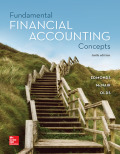
a.
Compute the gross margin for Company M using the FIFO cost flow assumption.
a.
Explanation of Solution
(1)
First-in-First-Out:
In First-in-First-Out method, the costs of the initially purchased items are considered as cost of goods sold, for the items which are sold first. The value of the ending inventory consists of the recent purchased items.
Compute the gross margin for Company M using the FIFO cost flow assumption as follows:
| FIFO | Units | Unit Cost (in $) | Amount (in $) | Cost of Goods Sold (in $) |
| Sales | 370 | 90 | 33,300 | |
| Less: Cost of goods sold: | ||||
| Beginning inventory | 90 | 40 | 3,600 | |
| Purchases | 280 | 45 | 12,600 | (16,200) |
| Gross margin | 1,500 | $17,100 |
Table (1)
Hence, the gross margin for Company M using the FIFO cost flow assumption is $17,100.
(2)
Last-in-Last-Out:
In Last-in-First-Out method, the costs of last purchased items are considered as the cost of goods sold, for the items which are sold first. The value of the closing stock consists of the initial purchased items.
Compute the gross margin for Company M using the LIFO cost flow assumption as follows:
| LIFO | Units | Unit Cost (in $) | Amount (in $) | Cost of Goods Sold (in $) |
| Sales | 370 | 90 | 33,300 | |
| Less: Cost of goods sold: | ||||
| Purchases | 310 | 45 | 13,950 | |
| Beginning inventory | 60 | 40 | 2,400 | (16,350) |
| Gross margin | 1,500 | $16,950 |
Table (2)
Hence, the gross margin for Company M using the LIFO cost flow assumption is $16,950.
(3)
Weighted-average cost method:
Under Weighted average cost method, the company calculates a new average cost after every purchase is made. It is determined by dividing the cost of goods available for sale by the units on hand.
Compute the gross margin for Company M using the weighted average cost flow assumption as follows:
| Weighted Average | Units | Unit Cost (in $) | Amount (in $) | Cost of Goods Sold (in $) |
| Sales | 370 | 90 | 33,300 | |
| Less: Cost of goods sold: | ||||
| Average cost per unit | 370 | 43.875 | 16,234 | (16,234) |
| Gross margin | 1,500 | $17,066 |
Table (3)
Working Note:
Compute the average unit cost:
Hence, the gross margin for Company M using the weighted average cost flow assumption is $17,066.
b.
Ascertain the amount of net income using FIFO, LIFO, and weighted average.
b.
Explanation of Solution
Net Income:
Net income is the sum total of all the revenues generated in a particular accounting period after deducting cost of goods sold and expenses and losses, such as rent expense,
Ascertain the amount of net income using FIFO, LIFO, and weighted average as follows:
|
FIFO |
LIFO |
Weighted Average | |
| Sales | $33,300 | $33,300 | $33,300 |
| Less: Cost of Goods Sold | (16,200) | (16,350) | (16,234) |
| Gross Margin | 17,100 | 16,950 | 17,066 |
| Less: Operating Expenses | 4,100 | 4,100 | 4,100 |
| Net Income | $13,000 | $12,850 | $12,966 |
Table (4)
Hence, the amount of net income using FIFO, LIFO, and weighted average are $13,000, $12,850, and $12,966 respectively.
c.
Compute the amount of ending inventory using FIFO method.
c.
Explanation of Solution
Ending Inventory:
It represents the quantity and price of the goods unsold and laying at the store at the end of a particular period.
(1)
Compute the amount of ending inventory using FIFO method as follows:
| Units | Unit Cost (in $) | Ending Inventory (in $) | |
| FIFO | 30 | 45 | 1,350 |
Table (5)
(2)
Compute the amount of ending inventory using LIFO method as follows:
| Units | Unit Cost (in $) | Ending Inventory (in $) | |
| LIFO | 30 | 40 | 1,200 |
Table (6)
(3)
Compute the amount of ending inventory using weighted average method as follows:
| Units | Unit Cost (in $) | Ending Inventory (in $) | |
| Weighted Average | 30 | 43.875 | 1,316 |
Table (7)
Want to see more full solutions like this?
Chapter 5 Solutions
Fundamental Financial Accounting Concepts
- Help me solve thisarrow_forwardFinancial Accounting please answerarrow_forwardThe Patidar Group manufactures and sells a single product, Product T. Budgeted sales for June are $450,000. Gross Margin is budgeted at 35% of sales dollars. If the net income for June is budgeted at $62,500, the budgeted selling and administrative expenses are?arrow_forward

 AccountingAccountingISBN:9781337272094Author:WARREN, Carl S., Reeve, James M., Duchac, Jonathan E.Publisher:Cengage Learning,
AccountingAccountingISBN:9781337272094Author:WARREN, Carl S., Reeve, James M., Duchac, Jonathan E.Publisher:Cengage Learning, Accounting Information SystemsAccountingISBN:9781337619202Author:Hall, James A.Publisher:Cengage Learning,
Accounting Information SystemsAccountingISBN:9781337619202Author:Hall, James A.Publisher:Cengage Learning, Horngren's Cost Accounting: A Managerial Emphasis...AccountingISBN:9780134475585Author:Srikant M. Datar, Madhav V. RajanPublisher:PEARSON
Horngren's Cost Accounting: A Managerial Emphasis...AccountingISBN:9780134475585Author:Srikant M. Datar, Madhav V. RajanPublisher:PEARSON Intermediate AccountingAccountingISBN:9781259722660Author:J. David Spiceland, Mark W. Nelson, Wayne M ThomasPublisher:McGraw-Hill Education
Intermediate AccountingAccountingISBN:9781259722660Author:J. David Spiceland, Mark W. Nelson, Wayne M ThomasPublisher:McGraw-Hill Education Financial and Managerial AccountingAccountingISBN:9781259726705Author:John J Wild, Ken W. Shaw, Barbara Chiappetta Fundamental Accounting PrinciplesPublisher:McGraw-Hill Education
Financial and Managerial AccountingAccountingISBN:9781259726705Author:John J Wild, Ken W. Shaw, Barbara Chiappetta Fundamental Accounting PrinciplesPublisher:McGraw-Hill Education





